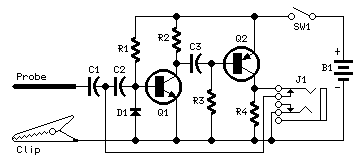Pulse-Generator & Signal-Tracer
Dual-purpose test-instrument
Very simple circuitry, 1.5V Battery-operated

Parts:
R1__________________1M 1/4W Resistor
R2,R4_______________2K7 1/4W Resistors
R3________________150K 1/4W Resistor
C1__________________2n2 630V Ceramic or Polyester Capacitor (See Notes)
C2,C3_______________4n7 63V Ceramic or Polyester Capacitors
D1_______________1N4148 75V 150mA Diode
Q1________________BC547 45V 100mA NPN Transistor
Q2________________BC557 45V 100mA PNP Transistor
SW1________________SPST miniature Slider Switch (See Notes)
J1_________________Stereo switched 3mm. Jack socket (See Notes)
Probe______________Metal Probe 3 to 5 cm. long
Clip_______________Miniature Crocodile Clip
B1_________________1.5V Battery (AA or AAA cell etc.)
Device purpose:
This simple circuit generates narrow pulses at about 700-800Hz frequency. The
pulses, containing harmonics up to the MHz region, can be injected into audio or
radio-frequency stages of amplifiers, receivers and the like for testing
purposes. A high-pitched tone can be heard from the speaker of the device under
test when all is working properly. The clip must be connected to the ground of
the device under test, touching with the probe the different stages of the
circuit, starting from the last stage and going up towards the first. When the
tone is no longer heard, the defective stage has been found.
Connecting an earclip or headphone to J1, the circuit will automatically change
into a two-stage amplifier and any audio signal coming from the device under
test and picked-up by the probe will be heard through the headphones. The
testing of a circuit should be made in the reverse manner, i.e. starting from
the first stage and going down until the last stage. When nothing is heard, the
defective stage has been found.
Circuit operation:
Q1 & Q2 form a complementary astable multivibrator, whose operating frequency
is set mainly by R3, C2 & C3 values. Output pulses are taken at Q2 Collector and
applied to the probe by means of decoupling capacitor C1. D1 provides a
symmetrical shape for the output waveform.
If an earclip or headphone jack is plugged into J1, the connection from Q2
Collector and C1-C2 is broken by the switch incorporated into J1: in this case
the circuit becomes a two-stage amplifier.
Notes:
- If you intend to use the circuit to test valve operated devices C1 must be a 630V type. Working with low voltage supply transistor devices the voltage of C1 can be lowered to 63 or 100V.
- If instead of a short probe, you intend to connect the circuit to the device under test by means of a piece of wire longer than a few centimeters, a small ceramic capacitor (470 to 1000pF) should be added in parallel to D1 to prevent unwanted RF oscillation.
- Current drawing when in Pulse-Generator mode is about 60ВµA and 1.2mA when in Signal-Tracer mode operation. Therefore SW1 can be omitted, provided that the earclip or headphones are unplugged when the circuit is unused.
- J1 is a stereo switched jack socket wired to obtain a series connection of
the two earpieces forming a stereo headphone. In this manner the circuit is
loaded with a higher impedance and sensitivity will be improved.
Therefore, the higher the load impedance the more sensitive the Signal-Tracer. In any case, common 32 Ohm impedance mini-headphones suitable for walkman sets will work fine. - A crystal (high impedance) earpiece is a good solution, provided you substitute J1 with a mono switched jack socket.
- The entire circuit can be easily fitted into a pen-like enclosure, with the probe protruding like a nib.
Title: Pulse-Generator & Signal-Tracer
electronic circuit
Source: www.redcircuits.com
Published on: 2005-02-03
Reads: 1388
Print version: ![]()
Other electronic circuits and schematics from Oscillators and timers
-
72 LED Clock
-
50 Hertz LED Clock Timebase
-
Mini Metronome
-
Jogging Timer
-
Sawtooth wave generator
-
1KHz Sinewave Generator
-
Low Voltage, High Current Time Delay Circuit
-
9 Second Digital Readout Countdown Timer
-
Low Frequency Sinewave Generators
-
Timed Beeper
